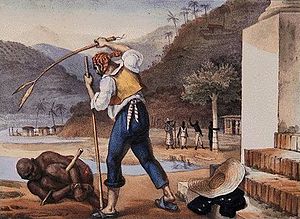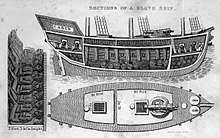
| Home | Sources Directory | News Releases | Calendar | Articles | | Contact | |
Slavery in Brazil

| Part of a series on |
| Slavery |
|---|
| Early history |
| History – Antiquity – Aztec Ancient Greece – Rome Medieval Europe Thrall – Kholop – Serfdom |
| Slavery and religion |
| The Bible – Judaism Christianity – Islam |
| By country or region |
| Africa – Atlantic – Arab Coastwise – Angola Barbary Coast Britain and Ireland British Virgin Islands Brazil – Canada – India – China Iran – Japan – Libya – Mauritania Ottoman empire Romania – Spanish New World Sudan – Sweden – Texas – United States |
| Contemporary |
| Modern Africa – Debt bondage Peonage – Penal labour Sexual slavery – Wage slavery Unfree labour – Human trafficking Contemporary slavery |
| Opposition and resistance |
| Timeline – Abolitionism Compensated emancipation Opponents of slavery–Ž Slave rebellion – Slave narrative |
Slavery in Brazil shaped the country's social structure and ethnic landscape. During the colonial epoch and for over six decades after the 1822 independence, slavery[1] was a mainstay of the Brazilian economy, especially in mining and sugar cane production.
Brazil obtained 35.4% of all enslaved Africans traded in the Atlantic slave trade. More than 3 million Africans were sent to Brazil to work mainly on sugar cane plantations from the 16th to the 19th century. Starting around 1550, the Portuguese began to trade enslaved Africans due to two main reasons:
- The unenculturated indigenous peoples deteriorated rapidly, and became increasingly wary of the Portuguese, thus, obtaining new indigenous slaves was becoming harder and harder.
- The Portuguese Empire, at the time, controlled some stages within the African slave trade's commercial chain, thus, providing the Brazilian landholders with the opportunity to import slaves from Portuguese trading posts in Africa. Portuguese, Brazilian, and African slave traders managed to profit even more from the increased demand.
During the 15th century, after realising the extension and importance of slave trading for the African economy, the Kingdom of Portugal's soldiers, explorers and merchants involved themselves in the trade in black enslaved Africans along with other tradable items through the establishment of several coastal trading posts. Starting around 1550, the Portuguese began to trade African slaves to work the sugar plantations they were developing in their newly-discovered colony of Brazil, once the European discoverers needed more human resources to use in the new continent, and the numbers of native indigenous peoples had declined. Although Portuguese Prime Minister Marquês de Pombal abolished slavery in mainland Portugal on the February 12th, 1761, slavery continued in Portugal's overseas colonies, particularly in Brazil, until its final abolition in 1888.
The enslaved Africans were useful for the sugar plantations in many ways. They were less vulnerable to tropical diseases. Slavery was practiced among all classes. From the late 18th century to the 1830s, including by the time of the Rebellions in Bahia, slaves were owned by the upper and middle classes, by the poor, and even by other slaves.[2]
The benefits of using the enslaved Africans far exceeded the costs to the owners. After 2'3 years, enslaved Africans repaid the cost of buying them, and slave plantation owners began to make profits from them. Brazil's plantation owners made lucrative profits per year. The very harsh manual labour of the sugar cane fields involved slaves using hoes to dig large trenches. They planted sugar cane in the trenches and then used their bare hands to spread manure.
A national survey conducted in 2000 by the Pastoral Land Commission, a Roman Catholic church group, estimated that there were more than 25,000 forced workers in Brazil. More than 1,000 slave-like laborers were freed from a sugar cane plantation in 2007 by the Brazilian Government.[3]
Contents |
[edit] Bandeira
From São Paulo the Bandeirantes, adventurers mostly of mixed Portuguese and Indian ancestry, penetrated steadily westward in their search for Indian slaves. Along the Amazon river and its major tributaries, repeated slaving raids and punitive attacks left their mark. One French traveller in the 1740s described hundreds of miles of river banks with no sign of human life and once-thriving villages that were devastated and empty. In some areas of the Amazon Basin, and particularly among the Guarani of southern Brazil and Paraguay, the Jesuits had organized their Jesuit Reductions along military lines to fight the slavers. In 1628, Antônio Raposo Tavares led a bandeira, composed of 2,000 allied Indians, 900 Mamluks (Mestizos) and 69 white Paulistanos, to find precious metals and stones or to capture Indians for slavery or both. This expedition alone was responsible for the destruction of most of the Jesuit missions of Spanish Guair�¡ and the enslavement of over 60,000 indigenous people.[4][5][6][7][8]
[edit] Quilombo
Escaped slaves formed Maroon[9] communities which played an important role in the histories of other countries such as Suriname, Puerto Rico, Cuba, and Jamaica. In Brazil the Maroon villages were called quilombos and the most famous was Quilombo dos Palmares. In the mid to late 19th century, many Amerindians were enslaved to work on rubber plantations.
[edit] Jean-Baptiste Debret
Jean-Baptiste Debret, a French painter who was active in Brazil in the first decades of the 19th Century, started out with painting portraits of members of the Brazilian Imperial family, but soon became concerned with the slavery of both blacks and the indigenous inhabitants. During the fifteen years Debret spent in Brazil, he not only concentrated on court rituals but the everyday life of slaves as well. His paintings on the subject (one of which appears on this page) helped draw attention to the subject in both Europe and Brazil itself.
[edit] Brazil, the world's largest sugar producer
The Clapham Sect, although their religious and political influence was more active in the Spanish Latin America, were a group of evangelical reformers that campaigned during much of the 19th century for the United Kingdom to use its influence and power to stop the traffic of slaves to Brazil. Besides moral qualms, the low cost of slave-produced Brazilian sugar meant that British colonies in the West Indies were unable to match the market prices of Brazilian sugar, and each Briton was consuming 16 pounds (7 kg) of sugar a year by the 19th century. This combination led to intensive pressure from the British government for Brazil to end this practice, which it did by steps over three decades. To this day, Brazil still is the world's largest sugar producer.[10]
[edit] Steps towards freedom
Brazil achieved independence from Portugal in 1822. José Bonif�¡cio de Andrade e Silva is credited as the "Father of Brazilian Independence". Around 1822, Representação to the Constituent Assembly was published arguing for an end to the slave trade and for the gradual emancipation of existing slaves. However, since this point until the 1880s, the Brazilian demand for slaves was filled by a gigantic increase in the importation of African slaves.

In 1848, the Brazilian slave trade continued on considerable level growing rapidly during the 19th century, and during this time the numbers reached as much as 60,000 slaves per year. Portugal and its territories in Africa had already stepped down from slave trade activities, but in other African coast's ports the slave trade continued. In Brazil, the foreign slave trade was finally abolished by 1850, and there were new laws on slave traffickers and speculators. Then, by 1871, the sons of the slaves were freed. In 1885, the slaves aged over 60 years were freed. The Paraguayan War contributed to end slavery, since slaves enlisted in exchange for freedom.
Brazil's 1877-78 Grande Seca (Great Drought) in the cotton-growing northeast, led to major turmoil, starvation, poverty and internal migration. As wealthy plantation holders rushed to sell their slaves in the south, popular resistance and resentment grew, inspiring numerous emancipation societies. They succeeded in banning slavery altogether in the province of Cear�¡ by 1884.[11]
[edit] Princess Isabel
Slavery was legally ended nationwide on May 13 by the Lei Áurea ("Golden Law") of 1888, by a legal act of Isabel, Princess Imperial of Brazil. In fact, it was an institution in decline by this time (since the 1880s the country began to attract European immigrant labor instead). Brazil was the last nation in the Western world to abolish slavery.
[edit] Modern slavery
In 1995, 288 farmworkers were freed from what was officially described as slavery, a total which rose to 583 in 2000. In 2001, however, the Brazilian government freed more than 1,400 slave laborers. Some believe that most cases probably go undetected. A national survey conducted in 2000 by the Pastoral Land Commission, a Roman Catholic church group, estimated that there were more than 25,000 forced workers and slaves in Brazil.[12]
In 2004 the Brazilian government acknowledged to the United Nations that 25,000-40,000 Brazilians work under work conditions "analogous to slavery." The top anti-slavery official in Brasília, nation's capital, estimates the number of modern slaves at 50,000.[13] More than 1,000 slave laborers were freed from a sugar cane plantation in 2007 by the Brazilian government, in the largest anti-slavery raid in modern times in Brazil.[3]
In 2008, the Brazilian government freed 4,634 slaves in 133 separate criminal cases at 255 different locations. Freed slaves received a total compensation of –2.4 million equal to ($4.8 million).[14]
[edit] See also
[edit] External Sources
[edit] References
- ^ Early Colonization
- ^ Rebellions in Bahia, 1798-l838. Culture of slavery
- ^ a b "'Slave' labourers freed in Brazil", BBC News.
- ^ bandeira
- ^ Bandeira - Encyclopedia Britannica
- ^ Bandeirantes
- ^ António Rapôso Tavares
- ^ Colonial Brazil: Portuguese, Tupi, etc
- ^ A Experiência histórica dos quilombos nas Américas e no Brasil
- ^ Struggling over sugar, St. Petersburg Times
- ^ Mike Davis, Late Victorian Holocausts, 88-90
- ^ Larry Rohter, Brazil's Prized Exports Rely on Slaves and Scorched Land, The New York Times, March 25, 2002
- ^ Hall, Kevin G., "Slavery exists out of sight in Brazil", Knight Ridder Newspapers, 2004-09-05.
- ^ Tom Phillips (January 3, 2009). "Brazilian task force frees more than 4,500 slaves after record number of raids on remote farms". http://www.guardian.co.uk/world/2009/jan/03/brazil-slavery-poverty-farm-workers.
[edit] Further reading
- http://links.jstor.org/sici?sici=0272-3433%28200221%2924%3A2%3C123%3ACWIBTF%3E2.0.CO%3B2-
- Report of the Brown University Steering Committee on Slavery and Justice
- Bethell, Leslie. The Abolition of the Brazilian Slave Trade. Britain, Brazil and the slave trade question, 1807-1869. Cambridge : Univ. Press, 1970.
- Conrad, Robert E. Destruction of Brazilian Slavery, 1850-1888. Berkeley : Univ. of California Press, 1972.
- Schwartz, Stuart B. Sugar plantations in the formation of Brazilian society. Bahia, 1550-1835. Cambridge: Cambridge University Press, 1985.
- Schwartz, Stuart B. Slaves, peasants, and rebels. Reconsidering Brazilian slavery. Urbana: Univ. of Illinois Press, cop. 1992.
|
SOURCES.COM is an online portal and directory for journalists, news media, researchers and anyone seeking experts, spokespersons, and reliable information resources. Use SOURCES.COM to find experts, media contacts, news releases, background information, scientists, officials, speakers, newsmakers, spokespeople, talk show guests, story ideas, research studies, databases, universities, associations and NGOs, businesses, government spokespeople. Indexing and search applications by Ulli Diemer and Chris DeFreitas.
For information about being included in SOURCES as a expert or spokesperson see the FAQ or use the online membership form. Check here for information about becoming an affiliate. For partnerships, content and applications, and domain name opportunities contact us.